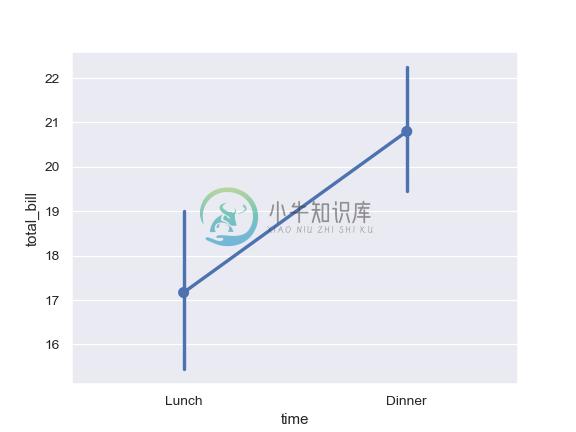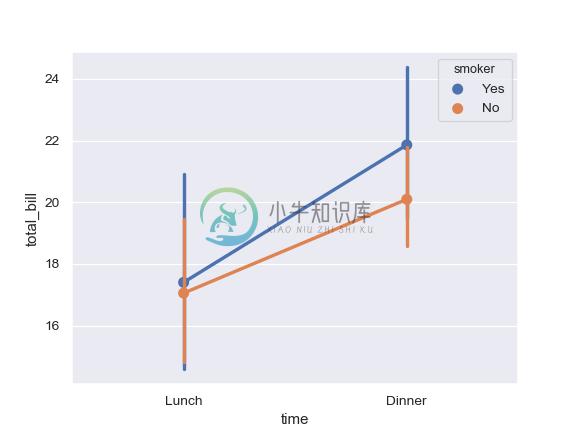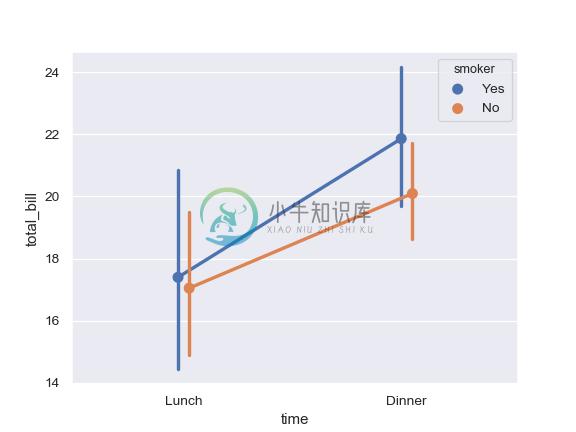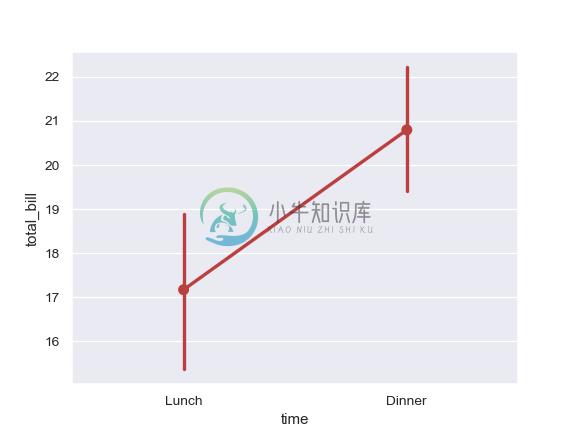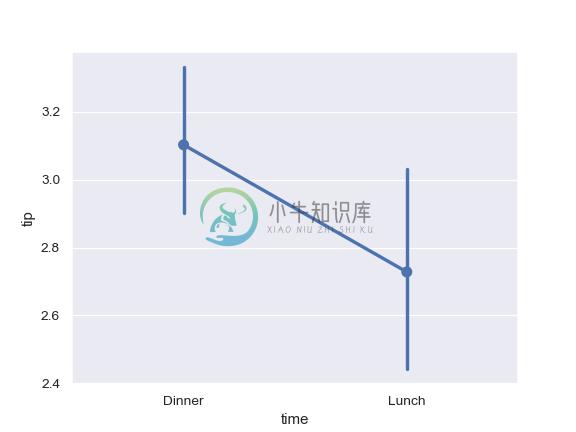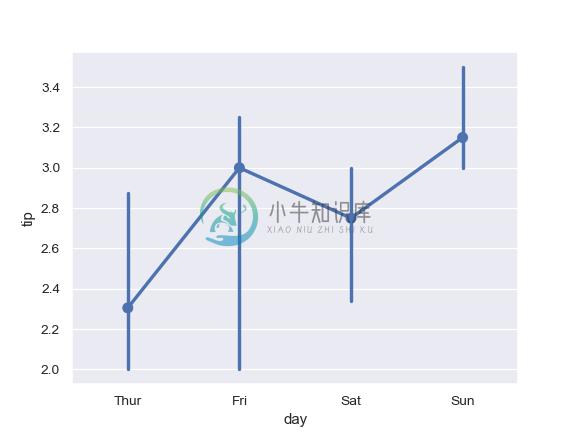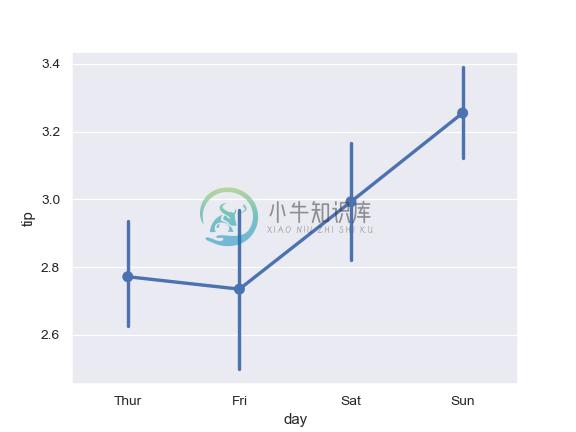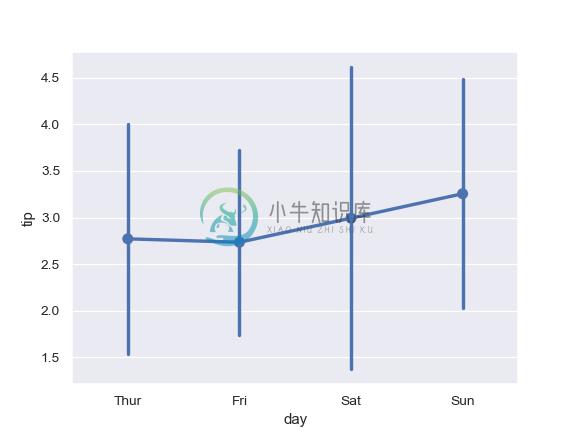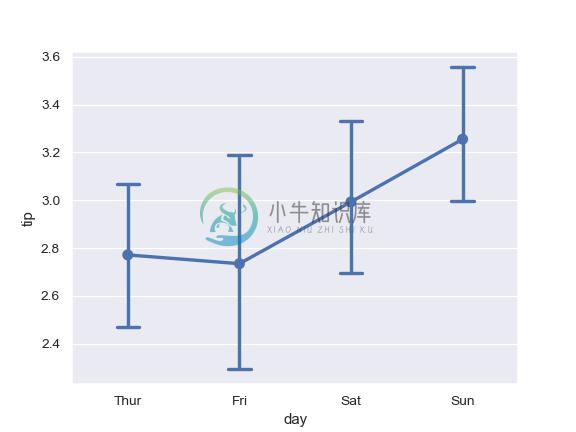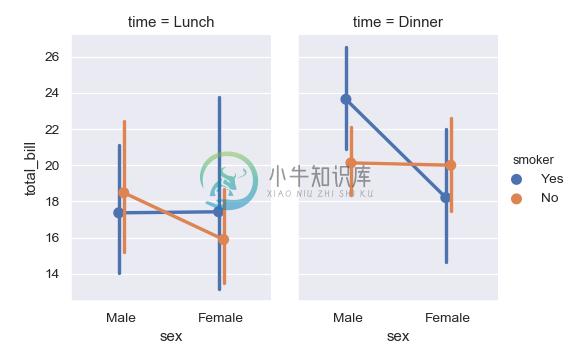seaborn.pointplot
seaborn.pointplot(x=None, y=None, hue=None, data=None, order=None, hue_order=None, estimator=<function mean>, ci=95, n_boot=1000, units=None, markers='o', linestyles='-', dodge=False, join=True, scale=1, orient=None, color=None, palette=None, errwidth=None, capsize=None, ax=None, **kwargs)
Show point estimates and confidence intervals using scatter plot glyphs.
A point plot represents an estimate of central tendency for a numeric variable by the position of scatter plot points and provides some indication of the uncertainty around that estimate using error bars.
Point plots can be more useful than bar plots for focusing comparisons between different levels of one or more categorical variables. They are particularly adept at showing interactions: how the relationship between levels of one categorical variable changes across levels of a second categorical variable. The lines that join each point from the same hue level allow interactions to be judged by differences in slope, which is easier for the eyes than comparing the heights of several groups of points or bars.
It is important to keep in mind that a point plot shows only the mean (or other estimator) value, but in many cases it may be more informative to show the distribution of values at each level of the categorical variables. In that case, other approaches such as a box or violin plot may be more appropriate.
Input data can be passed in a variety of formats, including:
- Vectors of data represented as lists, numpy arrays, or pandas Series objects passed directly to the
x,y, and/orhueparameters. - A “long-form” DataFrame, in which case the
x,y, andhuevariables will determine how the data are plotted. - A “wide-form” DataFrame, such that each numeric column will be plotted.
- An array or list of vectors.
In most cases, it is possible to use numpy or Python objects, but pandas objects are preferable because the associated names will be used to annotate the axes. Additionally, you can use Categorical types for the grouping variables to control the order of plot elements.
This function always treats one of the variables as categorical and draws data at ordinal positions (0, 1, … n) on the relevant axis, even when the data has a numeric or date type.
See the color_palette(), or a dictionary mapping hue levels to matplotlib colors.
errwidth:float, optional
Thickness of error bar lines (and caps).
capsize:float, optional
Width of the “caps” on error bars.
ax:matplotlib Axes, optional
Axes object to draw the plot onto, otherwise uses the current Axes.
返回值:ax:matplotlib Axes
Returns the Axes object with the plot drawn onto it.
See also
Show point estimates and confidence intervals using bars.Combine a categorical plot with a class:FacetGrid.
Examples
Draw a set of vertical point plots grouped by a categorical variable:
>>> import seaborn as sns
>>> sns.set(style="darkgrid")
>>> tips = sns.load_dataset("tips")
>>> ax = sns.pointplot(x="time", y="total_bill", data=tips)
Draw a set of vertical points with nested grouping by a two variables:
>>> ax = sns.pointplot(x="time", y="total_bill", hue="smoker",
... data=tips)
Separate the points for different hue levels along the categorical axis:
>>> ax = sns.pointplot(x="time", y="total_bill", hue="smoker",
... data=tips, dodge=True)
Use a different marker and line style for the hue levels:
>>> ax = sns.pointplot(x="time", y="total_bill", hue="smoker",
... data=tips,
... markers=["o", "x"],
... linestyles=["-", "--"])
Draw a set of horizontal points:
>>> ax = sns.pointplot(x="tip", y="day", data=tips)
Don’t draw a line connecting each point:
>>> ax = sns.pointplot(x="tip", y="day", data=tips, join=False)
Use a different color for a single-layer plot:
>>> ax = sns.pointplot("time", y="total_bill", data=tips,
... color="#bb3f3f")
Use a different color palette for the points:
>>> ax = sns.pointplot(x="time", y="total_bill", hue="smoker",
... data=tips, palette="Set2")
Control point order by passing an explicit order:
>>> ax = sns.pointplot(x="time", y="tip", data=tips,
... order=["Dinner", "Lunch"])
Use median as the estimate of central tendency:
>>> from numpy import median
>>> ax = sns.pointplot(x="day", y="tip", data=tips, estimator=median)
Show the standard error of the mean with the error bars:
>>> ax = sns.pointplot(x="day", y="tip", data=tips, ci=68)
Show standard deviation of observations instead of a confidence interval:
>>> ax = sns.pointplot(x="day", y="tip", data=tips, ci="sd")
Add “caps” to the error bars:
>>> ax = sns.pointplot(x="day", y="tip", data=tips, capsize=.2)
Use catplot() to combine a barplot() and a FacetGrid. This allows grouping within additional categorical variables. Using catplot() is safer than using FacetGrid directly, as it ensures synchronization of variable order across facets:
>>> g = sns.catplot(x="sex", y="total_bill",
... hue="smoker", col="time",
... data=tips, kind="point",
... dodge=True,
... height=4, aspect=.7);


